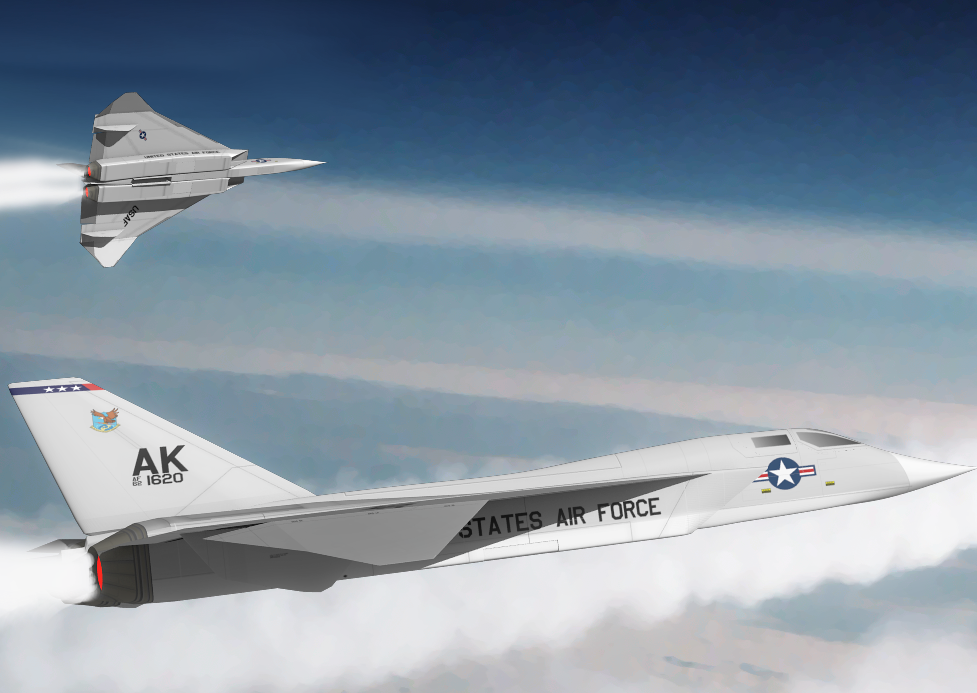
Artist’s impression of two F-108s attached to Elmendorf AFB, Alaska. Note: Top aircraft’s weapons bay opening.
Full-scale engineering mockup illustrating the round porthole-type window for the FCO. Taken on July 27, 1959, this is the latest known mockup photo, proving that the round FCO window was final.
This three-view shows a late configuration F-108A study, featuring pre-porthole FCO windows and ventral stabilizers extended circa early 1959. G. De Chiara © 2015
On September 23, 1959, the USAF abruptly cancelled the North American Aviation F-108A Rapier program. No further explanation was given.
The USAF Air Defense Command had planned to procure as many as 420 F-108 Rapiers to equip fighter-interceptor squadrons located at bases best suited to protect the US borders.
A great deal of speculation preceded the development of these planes, since the Hughes AN/ASG-18 radar and missile/rocket fire control system and Hughes GAR-9 (later designated AIM-47A) development programs were expected to be used in another interceptor that was under development. As it turned out, this speculation proved correct: in February 1964, the existence of the Lockheed YF-12A interceptor was announced by President Lyndon B. Johnson.
The history of the F-108 traces back to October 6, 1955, when the USAF ARDC issued a general operational requirement (GOR 114) that called for the development of an advanced long-range interceptor, experimental (LRI,X) for its Air Defense Command. It was to be capable of flying and fighting in any environment, armed exclusively with air-to-air missiles and/or rockets.
NAA received a letter contract on June 6, 1956, calling for a LRI with a combat speed of at least 2,000 mph (3-plus Mn) that could operate at seventy thousand feet in all types of weather, day or night. It was to be a complete weapon system (WS-202A) propelled by two afterburning turbojet engines, armed with nuclear warhead air-to-air guided missiles, and controlled by a two-man crew (pilot and weapons system operator).
COMPETITION
North American Aviation wasn’t the only airframe contractor to offer LRI designs to the USAF.
Martin initially suggested its Model 302, followed by its Model 308 (Model 302 alternate one) and Model 314 (Model 302 alternate two), before bowing out of the competition.
McDonnell offered several designs under its Models 109A and 109B, 110A, and 110B, and Model 111A; most of these featured the use of two afterburning Wright J67-W-1 turbojet engines. McAir Model 110A featured the use of three J67-W-1s.
Northrop came up with several offerings of its own. The first of these was its Model N-126 Delta Scorpion. The second was Model N-144, which it dubbed Long-Distance Interceptor. It then offered its Model N-167, which it referred to as a Two Engine Long Range Interceptor.
Republic offered its AP-75, which didn’t get further than the drawing board.
It’s unclear if some other airframe contractors, possibly Douglas or Lockheed, had also entered the LRI fray, but it is likely that they did.
In any event, it was the offering from NAA that got the nod—to no avail, as it turned out.
SUMMARY
The F-108A was expected to fly in March 1961 and to begin initial operations in January 1963, but the program was cancelled eighteen months prior to its projected first flight.
The abrupt cancellation of the F-108 Rapier program in September 1959 was shocking to say the least, for it had nearly come to fruition as far as its design and mockup development programs were concerned. That is, North American was nearly ready to cut first metal for the assembly of the prototypes, and was only waiting for a go-ahead with the award of a production contract. NAA had satisfied the demands of USAF ADC and it was ready to proceed to the next level. Even though NAA continued its development well into 1960, the USAF’s decision stood firm and its cancellation was final.
Why did the USAF cancel the F-108 program? Most aviation historians believe the reason was the advent of Lockheed’s family of A-12 aircraft, which produced the YF-12A. This aircraft carried the same radar and missile fire control system and missile armament slated for use by none other aircraft than the Rapier.
Specifications (XF-108)
General characteristics
Crew: two
Length: 89 ft 2 in (27.2 m)
Wingspan: 57 ft 5 in (17.5 m)
Height: 22 ft 1 in (6.7 m)
Wing area: 1,865 sq ft (173.4 m2)
Aspect ratio: 1.68
Empty weight: 50,907 lb (23,098 kg)
Gross weight: 76,118 lb (34,527 kg)
Max takeoff weight: 102,533 lb (46,508 kg)
Powerplant: 2 × General Electric J93-GE-3AR afterburning turbojet, 20,900 lbf (93 kN) thrust each dry, 29,300 lbf (130 kN) with afterburner
Performance
Maximum speed: 1,980 mph (3,190 km/h, 1,721 kn)
Stall speed: 105 mph (169 km/h, 91 kn)
Combat range: 1,162 mi (1,870 km, 1,010 nmi)
Ferry range: 2,487 mi (4,002 km, 2,161 nmi)
Service ceiling: 80,100 ft (24,400 m)
Rate of climb: 45,000 ft/min (230 m/s)
Wing loading: 40.8 lb/sq ft (199.2 kg/m2)
Thrust/weight: 0.77
Armament
Missiles: 3 × Hughes GAR-9A air-to-air missiles in a rotary weapons bay
Avionics
Hughes AN/ASG-18 look-down/shoot-down fire control radar